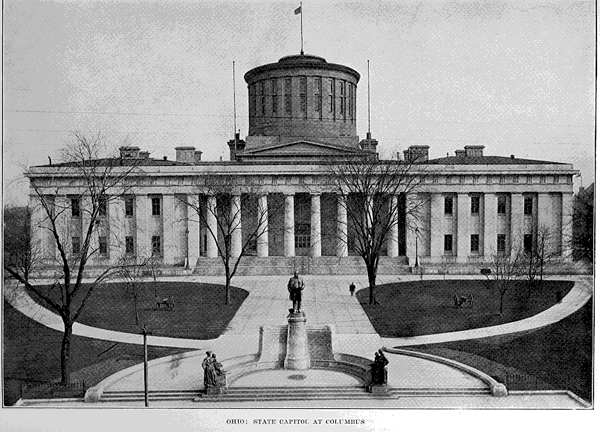Ohio's Early History
Below is an excerpt from the Standard Encyclopedia of the Alcohol Problem.
A north-central State of the United States; bounded on the north by Michigan and Lake Erie on the east by Pennsylvania and West Virginia, on the south by West Virginia and Kentucky, and on the west by Indiana; area, 41,040 square miles; population (est. 1928), 6,826,000. The capital is Columbus (est. pop. 291,400), and other important cities are Cleveland (984,500), Cincinnati (412,200), and Toledo (305,400).
The chief interests are mining, manufacturing, and oil. The agricultural wealth of the State is also great and much high-bred live stock is raised.
The territory now included in Ohio was first visited by Europeans in the middle of the seventeenth century, at which time it was occupied by various Indian tribes. The French claimed the region by right of discovery and occupation, and in 1749 Celeron de Bienville took formal possession of the upper Ohio Valley by planting leaden plates at the mouths of the principal rivers. The territory was also claimed by the English by right of the Cabots' discovery, and the charters of the Virginia and other colonies extended westward to the Pacific. About 1730, English traders from Pennsylvania and Virginia entered the eastern and southern parts; and in 1749 George II chartered the Ohio Company, formed by Virginia and London merchants, to colonize the west. The Company sent Christopher Gist down the Ohio River to explore the country as far as the mouth of the Scioto River, and four years later began the building of a fort at the forks of the Ohio. The French objected to this encroachment, however, and, driving the English away completed the fort for themselves calling it "Fort Duquesne." Seven years of hostilities known as the "French and Indian War," followed, which gave the entire northwest to England. Revolting under English rule the Indian allies of the French united in the Conspiracy of Pontiac to drive out the English; but the revolt was ended by Col. Henry Bouquet, who brought the Indians to terms in the Muskingum Valley in 1764.
After driving out the French from the west Great Britain disregarded the claims of her colonies to the western lands and on June 22, 1764, passed the Quebec Act, by which the region was annexed to Quebec. This action helped to bring on the Revolutionary War, during which the northwest country was won for America by the explorer George Rogers Clark. When the Articles of Confederation were submitted to the colonies for ratification, several of them refused to ratify unless the western lands were ceded to the Union. The result was the cession of these lands to the Government (1780-87), with the exception of the Western Reserve, a strip of 120 miles along Lake.Erie, containing 3,250,000 acres, exempted by Connecticut, but ceded in 1800 on condition that Congress guarantee the land titles already granted there, and the Military District, situated between the Little Miami and the Scioto rivers, reserved by Virginia for her Revolutionary soldiers.
Ohio was further colonized by the Second Ohio Company formed at Boston (1786) by New England officers and soldiers for the purpose of founding a new State between Lake Erie and the Ohio River. Ohio was included in the Northwest Territory created by the Ordinance of 1787, which provided a temporary government, with the understanding,, that as soon as the population was sufficient the Territory should be divided into separate States, not less than three nor more than five. Slavery was forbidden by the sixth article of the Ordinance, and the foundation of Ohio's interest in matters of education was laid in the third article, which read: "Religion, morality, and knowledge being necessary to good government and the happiness of mankind, schools and the means of education shall forever be encouraged." Ohio was first a part of the unorganized Northwest Territory (I 1887-99) and then of the organized Northwest Territory (1799-1800), and finally became the organized Territory of Ohio (1800-03). The first Territorial Government was established at Marrietta in October, 1787, with Gen. Arthur St. Clair as governor. His administration was mainly occupied by a final struggle with the Indians and by a conflict with the Legislature which greatly influenced the constitutional history of the State. The Indian uprisings were finally put down by Gen. Anthony Wayne, who defeated the Ohio Indians in the decisive battle of Fallen Timbers near the rapids of the Maumee River, on Aug. 20. 1794. By the Treaty of Greenville (Aug. 3, 1795) the Indians ceded all claims to practically the whole of the eastern and southern portions of Ohio.
---
Entry from the Standard Encyclopedia of the Alcohol Problem
About the League
Museum Hours
Monday-Saturday: 9am-6pm
Closed on Saturday: 1-2pm
Closed on Sunday









